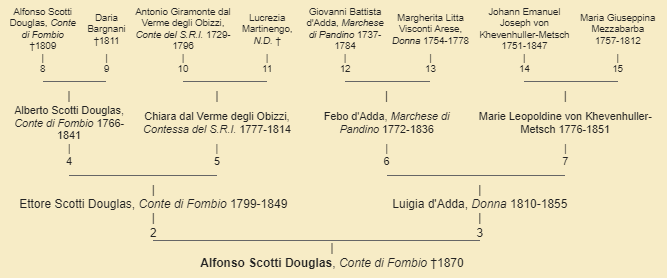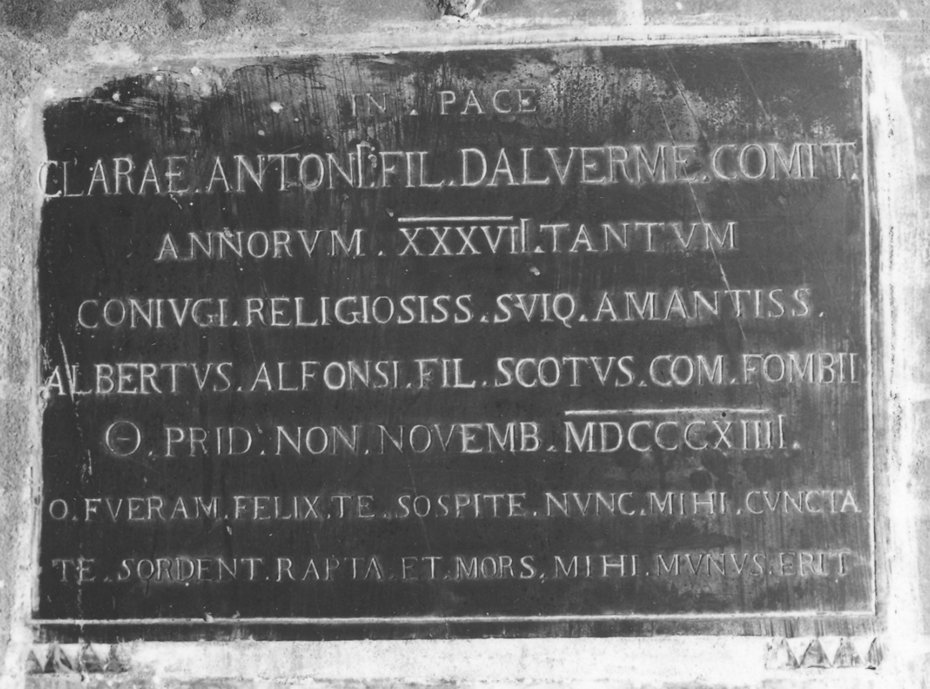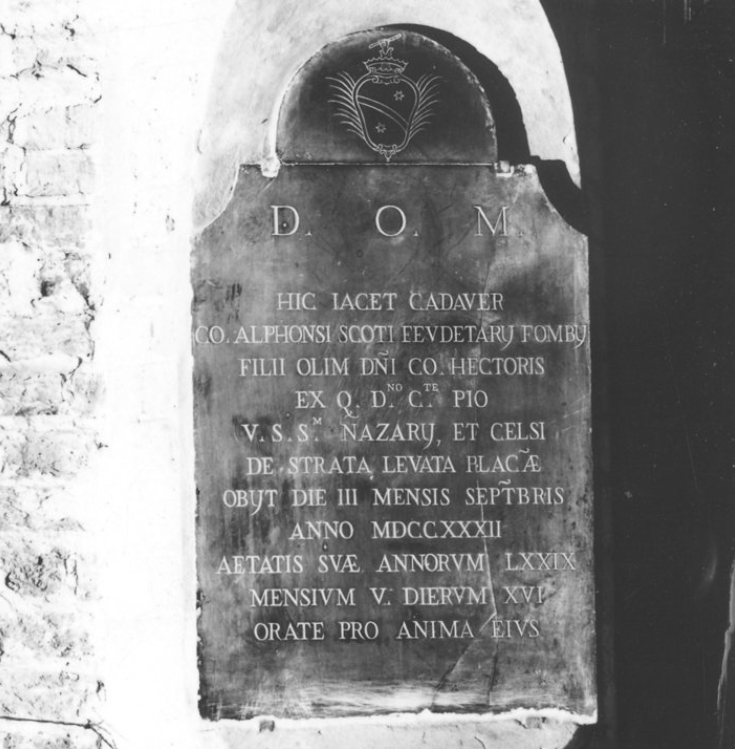The following is extracted, and translated from Guida al fondo Scotti Douglas di
Fombio e di Sarmato [pdf 15mb]:
Giacomo Antonio had the goods
and the feud of Casaliggio, brought as a dowry by his niece Barbara al
husband Ottaviano Caracciolo.
The descendants of Ettore depart
from the line of Ettore, extinct in the first half of the century. XVII,
the descendants of Alberto, which died out in 1735 on the death of
Giovanni, whom he called heirs of his own good the Scotti di Fombio of
the Piacenza line, and the descent of Lodovico
From the latter
and Ottavia Asinelli, among others, Odoardo was born, who died in 1620
fighting in the imperial armies during the Bohemian phase of the Thirty
Years' War in taking of Prague (Battle of the White Mountain), and
Girolamo Pio. From Girolamo Pio and Costanza Scotti di Sarmato descended
Ettore, husband of Caterina Caracciolo, who brought huge goods and half
of the castle of Statto, and father of Alfonso. Alfonso married Caterina,
heir to a branch of the Riva family, and from their union Giusto Ettore
was born, husband of Francesca Appiani d’Aragona, from which Alfonso
had. Alberto was born from Alfonso and Daria Bargnani of Brescia,
Chiara's husband from Worm and father of Ettore, who had Guglielmo from
Luisa D’Adda.
Guglielmo, who already owned the castle of Fombio
and many other properties, following the marriage celebrated in 1853
with Isabella Scotti di Sarmato inherited a large part of the heritage
of the branch of Sarmato, including the palace in via S. Siro.
Alfonso, who died in 1949 without heirs, and Isabella, married to
Giacomo, were born from his son Pietro Feltrinelli of Milan.
The
other son, Alberto, had a serious financial setback on the eve of the
First World War a due to which he had to alienate his properties and
move to Milan, where his family still reside descendants.
If
you can provide a better translation, it would be very welcome.

The Scotti Douglas Fondo of Fombio and
Sarmato
From the Archives of the State of Piacenza
The Scotti Douglas bottom of Fombio and Sarmato was born
in the second half of the sec. XIX when the isabella countess of Sarmato,
marrying the Guglielmo del Fombio, has brought the branch of Sarmato in
that of Fombio, bringing with him, to the death of Father Peter in 1863,
also the family archive, or at least a large part its.
Were laura
and giuseppe feltrinelli, heirs of the countess Isabella Scotti Douglas
of Fombio, to subscribe to the Deposit Convention in 1969. A second
convention was signed by Vincenzo and Lamberto Recepts in 1978, for
documents concerning Pradovera's goods that came to integrate L
'archive. In the 1969 Convention it was explicitly stated: "The archive
will be delivered to the current state of sorting and conservation that
does not allow an exact determination and identification of the
material". Since then and until today the fund had never been analyzed
in its complexity and in its entirety.
Consisting of 649
envelopes, 1355 between records and volumes and 895 parchments and only
approximately distinct between the two branches of the family, the fund
is currently preserved at the State Archive of Piacenza, after it had
been temporarily placed at the headquarters of the historical archive
Municipal. The documents cover a chronological arch that goes from the
sec. XIII (with copied documents from the century VIII) to the SEC. XX
and are only partially ordered and inventoried. They are divided into
twelve series or partitions, to which only in some cases correspond to
tools of accompanying the non-homogeneous characteristics, which in part
actually describe the situation in which the documents are found and
partly can only contribute to understanding how the archive is Via
sedimento. The rest of the documentation is preserved in envelopes that,
behind the orderly appearance, conceal into reality miscellaneous that
mix documents from various eras and various origins, with the frequent
mixture between cards belonging to the two branches of the Douglas
Scotti family. The consultation of the fund was therefore very
difficult.
Thanks to the financing of the Foundation of Piacenza
and Vigevano it was possible to implement an intervention project which,
although far from being an effective reorganization of the Fund, would
at least allowed a thread, perhaps, but sufficiently robust to be an
effective guide to Orient themselves between the cards, facilitating the
finding and consulting the documents. An analytical reconnaissance of
the documentation with mapping and control of the individual series and
partitions in which it is divided and of the corresponding means of
obligation to verify its effective utility. Lists of consistency for the
existing parts were drawn up; Topographic indexes and indexes for
partitions whose repertoires were not easy to use and understand. The
plot of the references and references that has thus been intertwining,
weaves the thread of relationships and possible links between the cards
we hope can be valid fortressing and stimulation for research and
in-depth.

|
Buried here, in the chapel where the members of the Scotti family had been buried for centuries, is Clara Dal Verme, wife of Alberto Scotti da Fombio, probably that Count Alberto Douglas Scotti da Fombio mentioned by Mensi (1899, p. 397) who held the important offices both under the Napoleonic empire and under the reign of the Duchess Maria Luigia: he was the first Maire of Piacenza, of which he was also Governor
|

|
Tombstone of Alfonso Scotti da Fombio
Note the arms are surmounted by a count's crown and an arm holding a stick. This appears unique to the Douglas Scotti of Fombio
family. |
See also:
•
Palazzo Scotti
• Castello Fombio
• The Douglas Scotti families of Fombio and Sarmato tree
• Italian heraldry
• Niccolò Scotti, k1514
For more on the Douglas Scotti families of Italy, see our
Italy portal.
|


